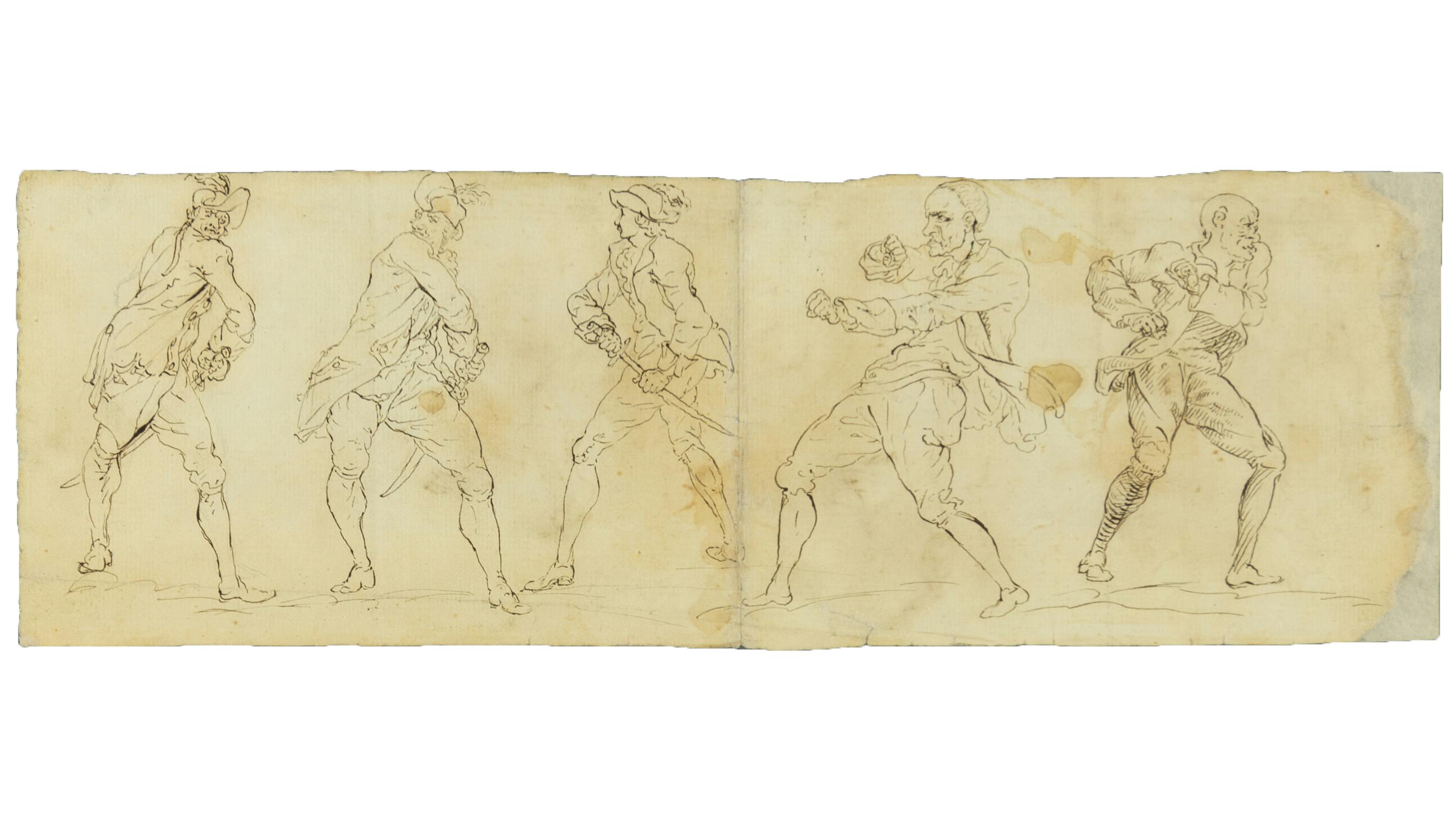Press Releases
Rare, Newly Discovered Eyewitness Sketch of Continental Army Sheds New Light on Wartime Life
March 26, 2024
An eyewitness pen-and-ink sketch depicting Continental Army soldiers and camp followers marching through Philadelphia on Aug. 25, 1777, which has never been documented or published by historians, has been donated to the Museum of the American Revolution. This sketch is the first wartime depiction of North Carolina troops known to exist, and only the second-known depiction of female camp followers of the Continental Army done by an eyewitness.
“This sketch is extremely important to our understanding of the daily operations of the Continental Army,” said Matthew Skic, Curator of Exhibitions at the Museum, who worked to authenticate the sketch and identify its creator after discovering it in a private collection. “It helps us visualize the everyday lives of these troops – the joyous, the difficult, and the mundane.”
This discovery brings to light a lively scene which newspaper accounts confirm occurred the morning of Aug. 25, 1777, as the North Carolina Brigade and its commander, Brigadier General Francis Nash, marched to join the rest of General George Washington’s army before seeing action in both the Battle of Brandywine (Sept. 11, 1777) and the Battle of Germantown (Oct. 4, 1777).
The sketch shows two soldiers marching alongside an open-sided wagon, as well as a commissioned officer and a wagon driver mounted on horseback. Inside the wagon sit two women, one holding an infant, amongst various equipment and baggage of the brigade. Two men are also depicted riding on the back of the wagon.
The inclusion of female camp followers – who shared life on campaign with enlisted husbands and fathers and supported the troops by sewing, doing laundry, and selling food – exemplifies a direct defiance of known regulations at the time about how women following the army could use wagons. Earlier in August, before the march depicted in the sketch took place, Washington himself brought up issues of women and children slowing down his troops, calling them “a clog upon every movement.”
On the reverse of the North Carolina Brigade sketch are five studies of two male figures, one brandishing a sword and the other engaged in a fist fight. Artists frequently sketched studies like these when they were working on larger works, as it allowed them to try out different poses or details and to get a sense of the scale of the larger drawing or painting.

The sketch was acquired by Judith Hernstadt, a Manhattan-based urban and regional planner and former television executive, in the late 1970s from a New York City antiques dealer. Hernstadt donated the sketch to the Museum in 2023, but at the time, the identity of the artist who drew it was still unknown. An ink inscription below the vignette of the North Carolina Brigade reads, “an exact representation of a waggon belonging to the north carolina brigade of continental troops which passed thro Philadelphia august done by …” with the rest of the lettering cut away due to an old paper repair. After detailed research, handwriting analysis, and comparison to similar sketches, Skic identified the sketch’s creator to be Switzerland-born artist and collector Pierre Eugène du Simitière (1737-1784), who settled in Philadelphia in about 1774 and is now known for documenting the rising American Revolution as it happened. Du Simitière went on to create from-life profile portraits of prominent Revolutionary leaders including Washington and he suggested the motto “E Pluribus Unum” through his rejected design for the Great Seal of the United States in 1776. In 1782, he founded the first museum in the United States that was open to the public.
Many of Du Simitière’s significant manuscripts and drawings still exist and are available for researchers to study at both The Library Company of Philadelphia and the Library of Congress. It is yet to be determined if either sketch relates to another work by du Simitière but research is ongoing.
“We were thrilled to piece together the many illuminating and significant parts of this sketch’s history through our unparalleled scholarship here at the Museum of the American Revolution,” said Dr. R. Scott Stephenson, President and CEO of the Museum. “As we round out our celebration of Women’s History Month, we revel in the discovery of this new depiction of female camp followers as highlighting the lesser-known stories and critical roles of women throughout the American Revolution are at the heart of the Museum’s offerings.”
The sketch was conserved due to generous contributions from the North Carolina Society of the Cincinnati, which is comprised of descendants of officers of the North Carolina Continental Line.
“The North Carolina Society of Cincinnati is proud to support the conservation and framing of this important discovery, which serves as an important reminder that the intricate history of both our state and our nation is still unfolding,” said Society President George Lennon.
About Museum of the American Revolution
The Museum of the American Revolution uncovers and shares compelling stories about the diverse people and complex events that sparked America’s ongoing experiment in liberty, equality, and self-government. Through the Museum’s unmatched collection, immersive galleries, powerful theater experiences, and interactive elements, visitors gain a deeper appreciation for how this nation came to be and feel inspired to consider their role in ensuring that the promise of the American Revolution endures. Located just steps away from Independence Hall, the Museum serves as a portal to the region’s many Revolutionary sites, sparking interest, providing context, and encouraging exploration. The Museum, which opened on April 19, 2017, is a private, non-profit, and non-partisan organization. For more information, visit www.AmRevMuseum.org or call 877.740.1776.